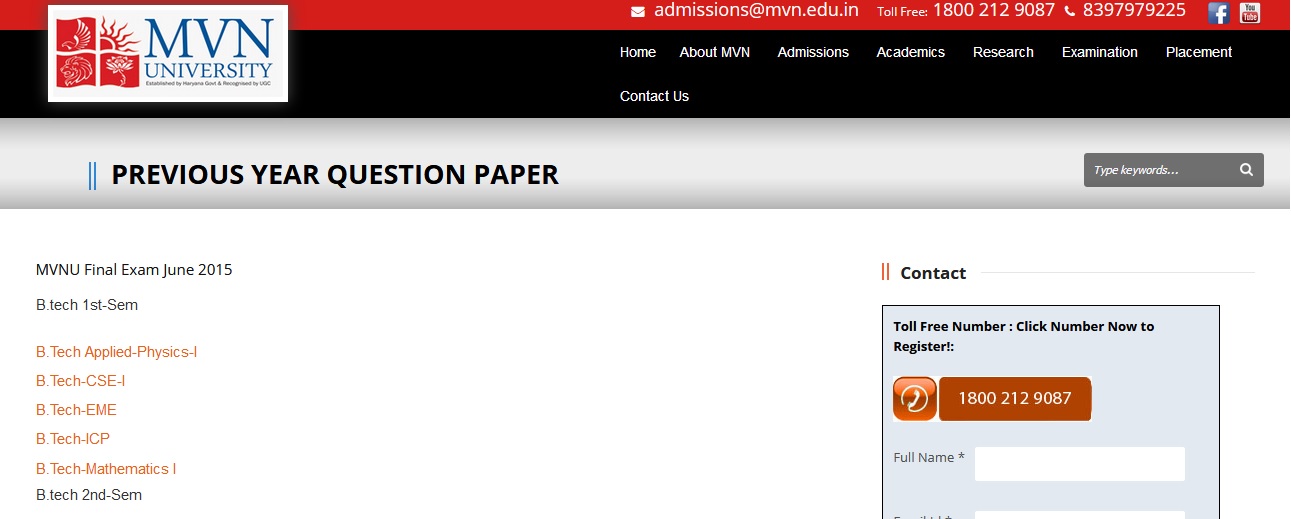MVN AHL001 Physics Diploma Previous Year Question Paper
Name of the College : MVN University
Subject Code/Name :AHL-001-Physics-I
Year : Jan.2014
Degree : Diploma
Sem : I
Website : mvn.edu.in
Document Type : Previous Year Question Paper
Download Model Question Paper : https://www.pdfquestion.in/uploads/mvn.edu.in/3184-Physics-I1.pdf
MVN Physics-I Previous Question Paper
Time Allowed: 03 hours.
Maximum Marks: 100
Related : MVN University AHL007 Language Communication Diploma Question Paper : www.pdfquestion.in/3182.html
Instructions
Before answering the question paper the candidate should ensure that they have been supplied the correct question paper. Complaints in this regard, if any, shall not be entertained after the examination.
Note: Question No. 1 is Compulsory and attempts any two questions from each section. All questions carry equal marks.

Previous Questions
1. a) What do you mean by refraction of light? Explain its laws. (5)
b) Distinguish between conduction, convection and radiation. (5)
c) State Newton’s IInd law of motion. Using it, derive the force equation. (5)
d) Define the term power and write its unit and dimensional formula. Differentiate between the units kWhr and kW. (5)
SECTION-A :
2. a) Explain CGS, MKS and SI system of units in detail. Write the units of force and work in all the three systems. (10)
b) What is principle of homogeneity of dimensions? Give uses and limitations of dimensional analysis. Convert a velocity of 36 km/hr into m/s using principle of homogeneity of dimensions. (10)
3. a) What is total internal reflection (TIR)? Explain with proper ray diagram.
Define critical angle. What are the conditions for TIR? (10)
b) Explain the construction, working and magnifying power of Astronomical telescope. (10)
4. a) Define reverberation. Explain it with an example. What do you mean by reverberation time? What are the methods to reduce reverberation time? (10)
(b) Derive the relation between velocity, frequency and wavelength of a wave. What is the importance of this relation? A hospital uses an ultrasonic scanner to locate tumors in a tissue. What is the wavelength of sound in a tissue, in which the speed of sound is 1.7 Km/s? The operating frequency of the scanner is 4.2 MHz. (10)
SECTION-B :
1. a) What are different scales of temperature? Write relationship between all of them. Convert 100° F into centigrade scale. (10)
b) Describe the principle, construction and working of a platinum resistance thermometer. Give its merits and demerits. (10)
6. a) State and prove principle of conservation of linear momentum. (10)
b) What do you mean by banking of tracks? Derive an expression for the banking of angle. A car is racing on a circular track of 180m radius and of banking angle 30º. To avoid the chances of skidding what should be the speed of the car? (10)
7. a) State and prove principle of conservation of energy. (10)
b) Determine work done against friction when (10)
i. A body moves over a horizontal surface.
ii. A body moves up an inclined plane.
Physics – II
Subject Code: AHL002
Time Allowed: 03 hours.
Maximum Marks: 100
Instructions
Before answering the question paper the candidate should ensure that they have been supplied the correct question paper.
Complaints in this regard, if any, shall not be entertained after the examination.
Attempt any five questions and all questions carry equal marks.
SECTION-A :
1(a) State Gauss’s law. Derive an expression for electric field due to non-conducting charged sphere using Gauss theorem. (2+8)
(b) Define capacitance. Give its SI unit. Derive an expression for the capacitance of parallel plate capacitor. (1+1+8)
2(a) What is Wheatstone bridge? Describe its principle and working with circuit diagram. (8)
(b) What are superconductors? Explain type-I and type-II superconductors. (2+5+5)
3(a) What are fundamental laws of radioactivity? Explain radioactive disintegration constant. (6+3)
(b) What is artificial radioactivity? How can it be produced? (2+4)
(c) What do you mean by radiation hazards? Explain its causes and effects. (5)
SECTION-B
4(a) What are the differences between intrinsic and extrinsic semiconductors? What is the effect of temperature on the conductivity of intrinsic semiconductors? (5+3)
(b) What are LED’s? What are its advantages over incandescent lamp? Give some applications also. (2+3+3)
(c) Explain NOT, NOR, NAND, XOR logic gates. (4)
5(a) What do you mean by LASER? Explain the basic structure of laser. (1+4)
(b) What is Ruby laser? Describe its principle and working with diagram. (8)
(c) What are optical fibers? Explain its principle. How does signal propagate through optical fibre? (7)
6(a) What are nanomaterials? Discuss its applications. (2+6)
(b) What are carbon nanotubes? Discuss its applications. (6+6)